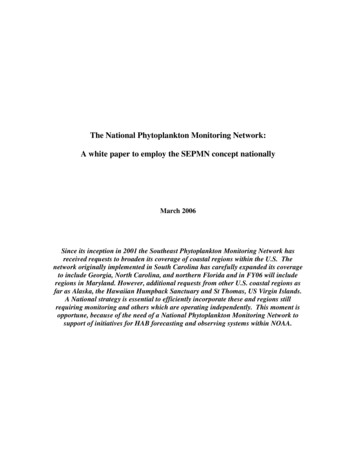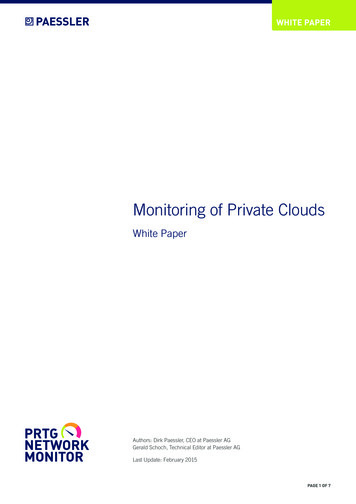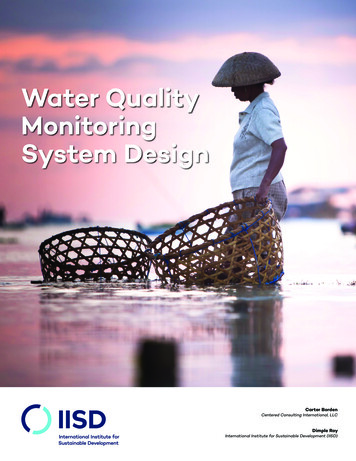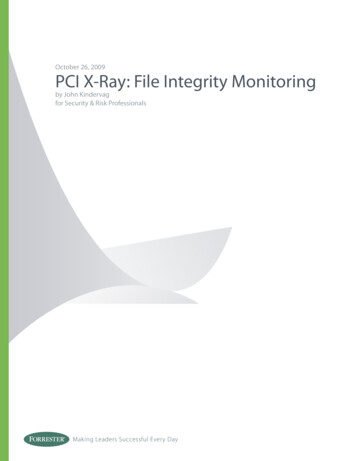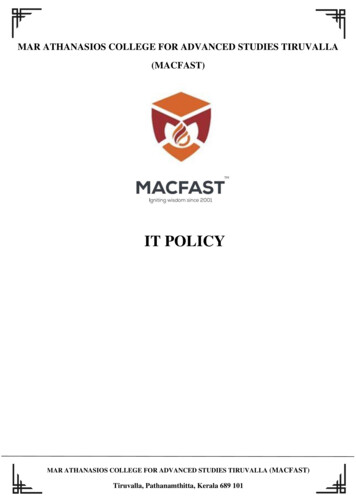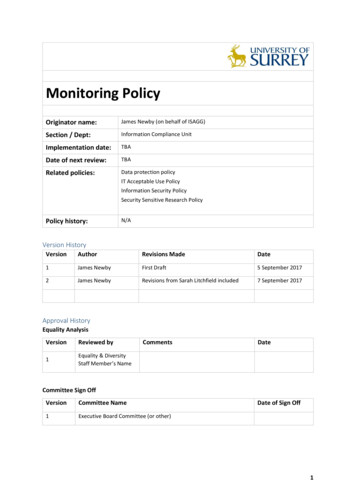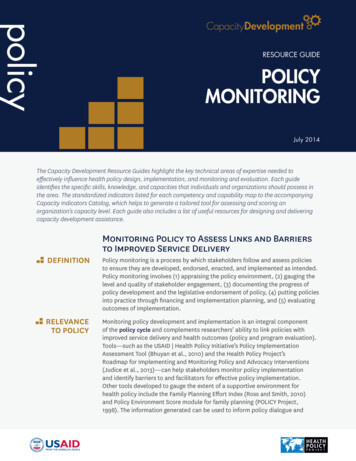
Transcription
CapacityDevelopmentRESOURCE GUIDEPOLICYMONITORINGJuly 2014The Capacity Development Resource Guides highlight the key technical areas of expertise needed toeffectively influence health policy design, implementation, and monitoring and evaluation. Each guideidentifies the specific skills, knowledge, and capacities that individuals and organizations should possess inthe area. The standardized indicators listed for each competency and capability map to the accompanyingCapacity Indicators Catalog, which helps to generate a tailored tool for assessing and scoring anorganization’s capacity level. Each guide also includes a list of useful resources for designing and deliveringcapacity development assistance.DEFINITIONRELEVANCETO POLICYMonitoring Policy to Assess Links and Barriersto Improved Service DeliveryPolicy monitoring is a process by which stakeholders follow and assess policiesto ensure they are developed, endorsed, enacted, and implemented as intended.Policy monitoring involves (1) appraising the policy environment, (2) gauging thelevel and quality of stakeholder engagement, (3) documenting the progress ofpolicy development and the legislative endorsement of policy, (4) putting policiesinto practice through financing and implementation planning, and (5) evaluatingoutcomes of implementation.Monitoring policy development and implementation is an integral componentof the policy cycle and complements researchers’ ability to link policies withimproved service delivery and health outcomes (policy and program evaluation).Tools—such as the USAID Health Policy Initiative’s Policy ImplementationAssessment Tool (Bhuyan et al., 2010) and the Health Policy Project’sRoadmap for Implementing and Monitoring Policy and Advocacy Interventions(Judice et al., 2013)—can help stakeholders monitor policy implementationand identify barriers to and facilitators for effective policy implementation.Other tools developed to gauge the extent of a supportive environment forhealth policy include the Family Planning Effort Index (Ross and Smith, 2010)and Policy Environment Score module for family planning (POLICY Project,1998). The information generated can be used to inform policy dialogue andH E A LT HPOLICYP R O J E C T
POLICY MONITORINGrecommendations for translating health policies into action. Policy monitoringcan and should be conducted by all stakeholder groups and requires expertisein different areas, such as advocacy, accountability systems, monitoring andevaluation, and data analysis.KEYCAPABILITIESPERFORMANCEIDEALPolicy monitoring requires stakeholders to understand how policies move throughthe process from development to implementation and the potential barriers toprogress. Specifically, effective policy monitoring requires an awareness andunderstanding of the policy environment; analytical skills, such as being ableto identify, develop, and apply assessment tools and analyze findings; and theability to mobilize communities to participate in the policy process, lead strongwell-coordinated advocacy efforts, and engage with a range of governmentdepartments and units (ActionAid, 2006).High capacity for monitoring policy development, adoption, andimplementation includes being able to Effectively and systematically collect, analyze, communicate, and usedata related to the process and outcomes of policy development andimplementation Use data (including financial data and data about service delivery and healthoutcomes) to improve policy development and implementation Build strong relationships among sectors and among individuals andorganizations to adequately monitor the full policy processIn the ideal, the following would exist: Opportunities and mechanisms that engage multiple sectors andorganizations in policy dialogue Systemic monitoring and evaluation of the impacts of policy formulation andimplementation for positive or negative effects A robust legal and regulatory framework that allows for a strong M&Esystem but also protects individuals’ rights (i.e., laws on the confidentialityof individuals’ health records and health status; data sharing amonginstitutions) National working groups/committees focused on policy monitoring, whichmeet regularly and have clear working objectives A national research agenda, which includes specific research priorities andstakeholders with interest in using the data collectedCapacity Development Resource Guide2
POLICY MONITORINGindividual competenciesKNOWLEDGE OFLocal and national policy environments, laws, and institutions related to health sectorissuesPM1Political processes, power brokering, and key political actors/champions in the healthsectorPM2Processes for the uptake of policy by national/subnational institutions, includingfunding mechanisms and other systemsPM3Benefits of and approaches to facilitating the use of evidence to inform differentstages of the policy processPM4M&E fundamentals, including how to develop specific, measurable, achievable,relevant, and time-bound (SMART) objectives, indicators, M&E systems, andevaluation designsPM5SKILLS TO BE ABLE TOListen, communicate, negotiate, and influence others to participate in monitoring theprocesses of policy development and implementationPM6Collect and analyze data from primary and secondary sources to monitor progress inthe policy processPM7Identify, analyze, and engage a broad spectrum of stakeholders in policy monitoring,including national-level policymakers, advocates, technical specialists, and citizengroupsPM8Identify where a policy issue or problem lies in the policy process and chart out apathway for successfully developing and/or implementing the policyPM9Develop routine data collection systems, including a policy monitoring plan,indicators, and data storage mechanismsPM10Design and implement process and outcome evaluations and/or operations researchstudies to evaluate policy implementationPM11Facilitate the use of information at different points in the policy processPM12Capacity Development Resource Guide3
POLICY MONITORINGATTITUDES/VALUES/ATTRIBUTESValues working in collaborationPM13Is committed and can remain engaged and monitor issues over the long termPM14organizational capabilitiesTECHNICAL ABILITY TOSystematically use qualitative and quantitative data collection techniques to receiveinput from constituencies on their needs, priorities, and interests and how policiesaffect themPM15Identify stakeholders and target audiences for monitoring information and analyzetheir position for potential support or oppositionPM16Identify where issues or problems exist within the policy development orimplementation process and chart an approach to successfully develop or implementthe policyPM17, P18Analyze and document implications of existing policy and proposed policyalternatives, especially from the perspectives of gender, equity, and stigma anddiscriminationPM19Develop an M&E plan to track short- and intermediate-term changes in the policyprocess to accurately assess attribution or contribution to longer-term changethrough policy implementationPM20Systematically evaluate the effectiveness of different policy interventions (e.g.,advocacy, policy dialogue, policy analysis, strategic planning) to determinecontributions to policy outcomes and learn lessons to improve future activitiesPM21Communicate findings of policy monitoring through various communication channelsto groups who could use the findings for decision making, advocacy, etc.PM22RELATIONAL ABILITY TOMaintain constructive links with various policy stakeholders, including communities,policymakers, advocates, and civil society organizationsPM23Earn credibility with the public, constituents, media, and donors to ensure thataccurate information is collected and that these stakeholders trust the informationproduced through policy monitoringPM24Influence others to participate in monitoring the processes of policy development andimplementationPM25Provide training/technical assistance to other organizations on policy monitoringPM26Capacity Development Resource Guide4
POLICY MONITORINGORGANIZATIONAL OPERATIONS AND MANAGEMENT TO SUPPORTThe allocation of dedicated resources (staff, time, money) to policy monitoring effortsPM27Systems to collect, analyze, and synthesize data related to the policy processPM28Innovation and adaptation of approaches in response to the changing environment,internally and externallyPM29Capacity Development Resource Guide5
POLICY IES Conduct training on the policy process and monitoring and evaluation forgovernment institutions, civil society, key populations, etc. Engage lawyers and others with expertise in the legal and regulatoryframework and policy process to provide technical assistance to individualsand organizations responsible for policy monitoring Facilitate multisectoral workshops on the development and implementationof policy monitoring plans Provide experiential learning opportunities to design, conduct, and useinformation from an evaluation of policy implementation Support advocacy for country-owned systems for ongoing policy monitoringRESOURCESBhuyan, A., A. Jorgensen, and S. Sharma. 2010. Taking the Pulse of Policy: The PolicyImplementation Assessment Tool. Washington, DC: Futures Group, Health Policy Initiative, TaskOrder 1. Available at: http://pdf.usaid.gov/pdf docs/PNADX728.pdf.Catholic Agency for Overseas Development (CAFOD), Christian Aid, and Trocaire. 2013.Monitoring Government Policies: A Toolkit for Civil Society Organisations in Africa. London:CAFOD, Christian Aid, Trocaire. Available at: http://commdev.org/files/1818 filemonitoringgovernmentpolicies.pdf.Chapman, J., and A. Wameyo. 2001. “Monitoring and Evaluating Advocacy.” PLA Notes 43:48–52. Available at: http://www.g-rap.org/docs/monitoring and evaluation/chapmanwameyo 2001 me on advocacy.pdf.Frankel, N., and A. Gage. 2007. “M&E Fundamentals.” Chapel Hill, NC: MEASURE Evaluation.Available at: damentals and -courses/m-e-fundamentals-en.Fretheim, A., A.D. Oxman, J.N. Lavis, and S. Lewin. 2009. “SUPPORT tools for Evidence-InformedPolicymaking in Health 18: Planning monitoring and evaluation of policies.” Health Res Policy Syst.7 Suppl 1. S18. Available at: , K., L. Irani, R. MacInnis, and M. Hamilton. 2012. “Linking Health Policy withHealth Systems and Health Outcomes: A Conceptual Framework.” Washington, DC: FuturesGroup, Health Policy Project. Available at: olicySystemOutcomesConceptualALDec.pdf.Health Policy Project. 2013. “Policy Monitoring.” Washington, DC: Futures Group, Health PolicyProject. Available at: http://www.healthpolicyproject.com/index.cfm?id topics-policyMonitoring.International HIV/AIDS Alliance and International Council of AIDS Service Organizations. 2010.“Measuring Up: HIV-Related Advocacy Evaluation Training Pack.” Brighton, UK: International HIV/AIDS Alliance. Available at: px?Id 477.Judice, R., J. Lane, A. Katz, R. MacInnis, M. Hijazi, et al. 2013. “Roadmap for Implementing andMonitoring Policy and Advocacy Interventions.” Washington, DC: Futures Group, Health PolicyProject. Available at: http://www.healthpolicyproject.com/index.cfm?id publications&get pubID&pubID 325.MacDonald, L., and R. Levine. 2008. “Learning While Doing: A 12-Step Program for PolicyChange.” Washington, DC: Center for Global Development. Available at: http://www.cgdev.org/files/15417 file PolicyChange.pdf.Capacity Development Resource Guide6
POLICY MONITORINGMalajovich, L. 2011. Handbook for Budget Analysis and Tracking in Advocacy Projects. New York, NY: International PlannedParenthood Federation. Available at: s.MEASURE Evaluation. 2011. “Data Demand and Use Concepts and Tools: A Training Tool Kit.” Chapel Hill, NC: MEASUREEvaluation. Available at: raining-materials.html.POLICY Project. 1998. “Policy Environment Score.” Washington, DC: POLICY Project, Futures Group. Available at: cfm?a0 2c.Reisman, J., A. Gienapp, and S. Stachowiak. 2007. A Guide to Measuring Advocacy and Policy. Baltimore, MD: Annie E.Casey Foundation. Available at: H5000.pdf.Ross, J., and E. Smith. 2010. The Family Planning Effort Index: 1999, 2004, and 2009. Washington, DC: FuturesGroup, USAID Health Policy Initiative, Task Order 1. Available at: /Documents/1110 1 FP Effort Index 1999 2004 2009 FINAL 05 08 10 acc.pdf.Capacity Development Resource Guide7
POLICY MONITORINGSuggested citation: Health Policy Project. 2014. “Capacity Development Resource Guide: Policy Monitoring.” Washington,DC: Futures Group, Health Policy Project.ISBN: 978-1-59560-036-3This resource guide is part of an Organizational Capacity Assessment (OCA) suite of tools. The USAID-funded Health PolicyProject developed the suite to help organizations assess and strengthen their capacity to contribute to improved healthsystems and health outcomes. The tools include an overview of the OCA approach, a facilitator guide, a series of capacitydevelopment resource guides, and a Capacity Indicators Catalog. The suite is available at www.healthpolicyproject.com.The Health Policy Project is a five-year cooperative agreement funded by the U.S. Agency for International Developmentunder Agreement No. AID-OAA-A-10-00067, beginning September 30, 2010. It is implemented by Futures Group, incollaboration with Plan International USA, Futures Institute, Partners in Population and Development, Africa Regional Office(PPD ARO), Population Reference Bureau (PRB), RTI International, and the White Ribbon Alliance for Safe Motherhood(WRA).The information provided in this document is not official U.S. Government information and does not necessarily represent theviews or positions of the U.S. Agency for International Development.Capacity Development Resource Guide8
Monitoring Policy to Assess Links and Barriers to Improved Service Delivery. DEFINITION. Policy monitoring is a process by which stakeholders follow and assess policies to ensure they are developed, endorsed, enacted, and implemented as intended. Policy monitoring involves (1) appraising the policy environment, (2) gauging the




